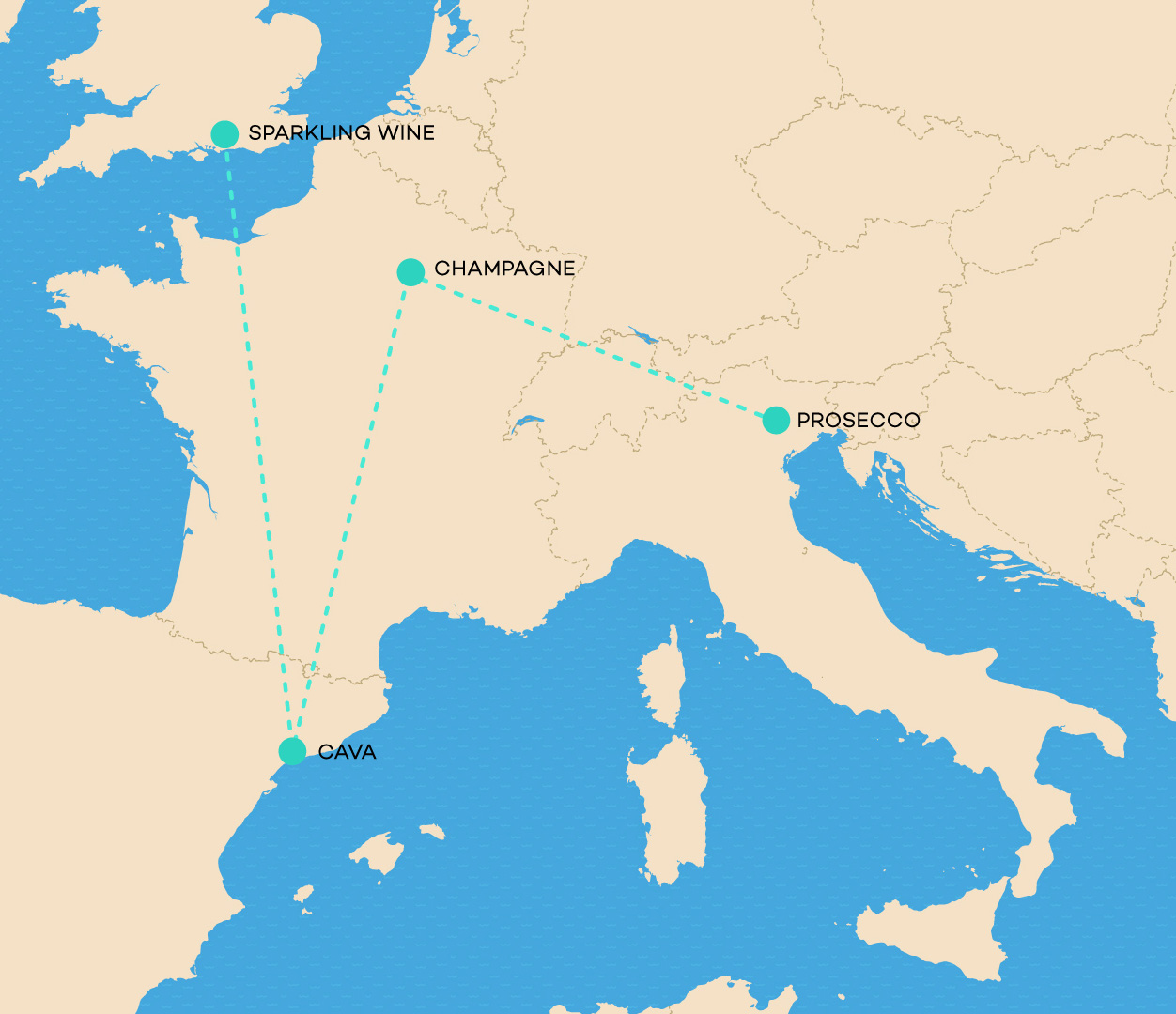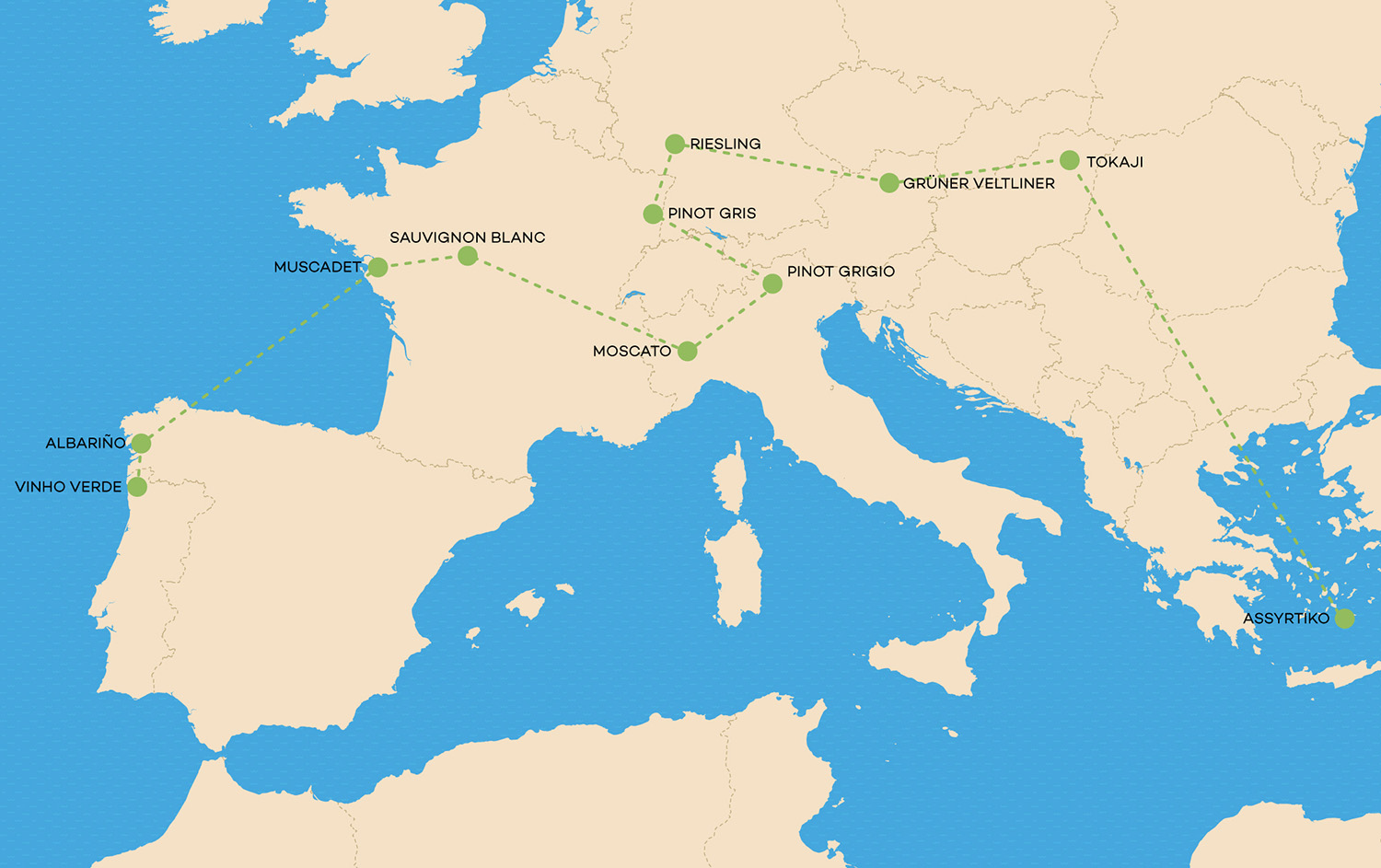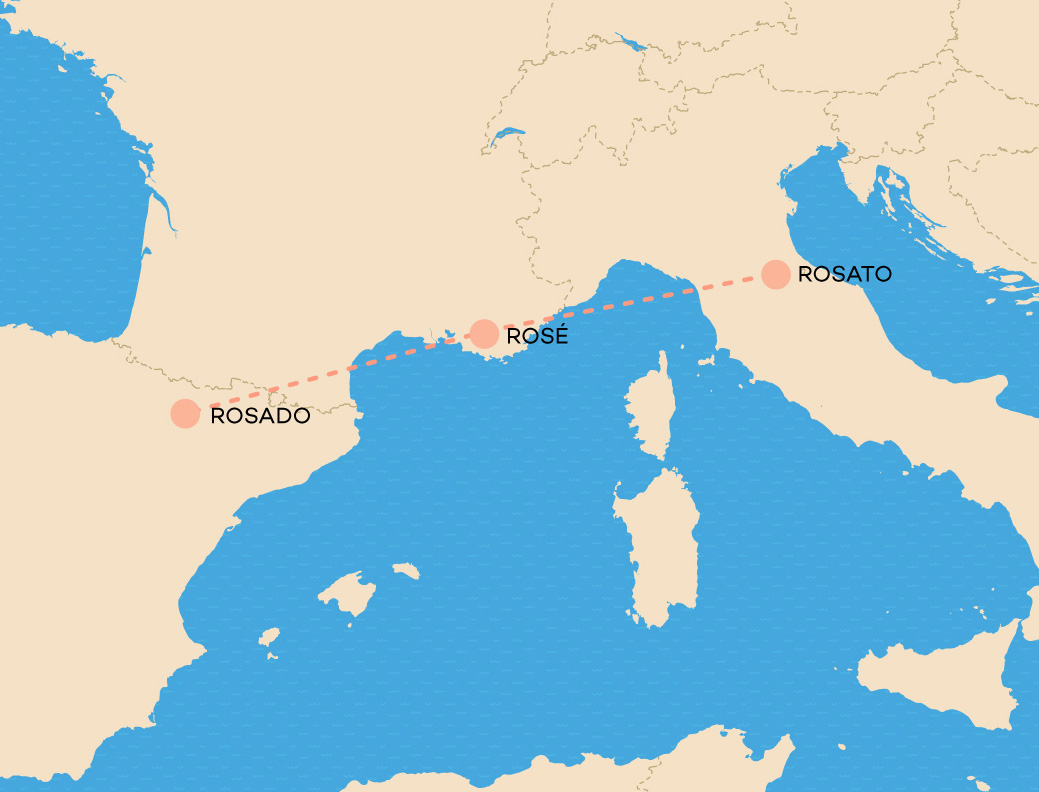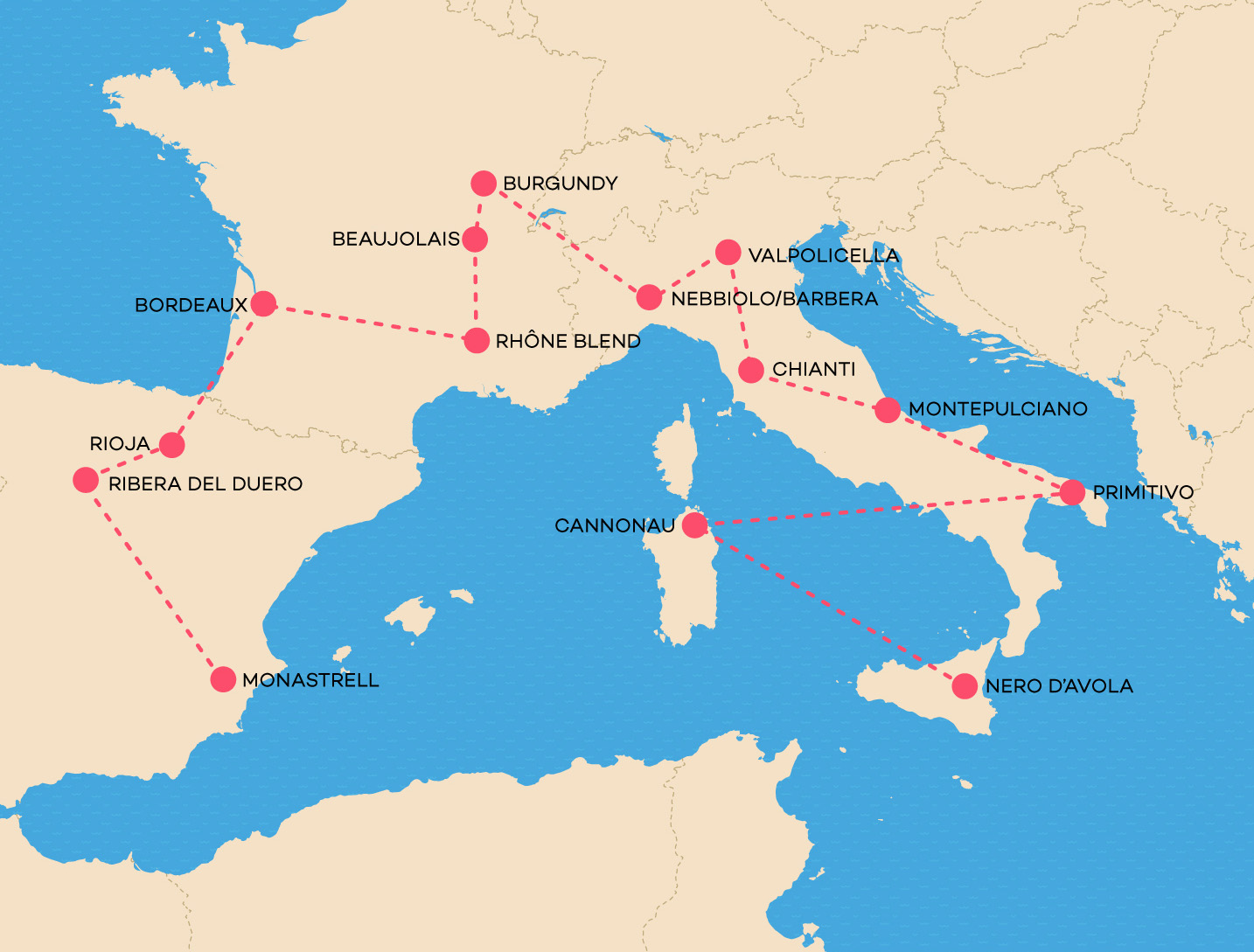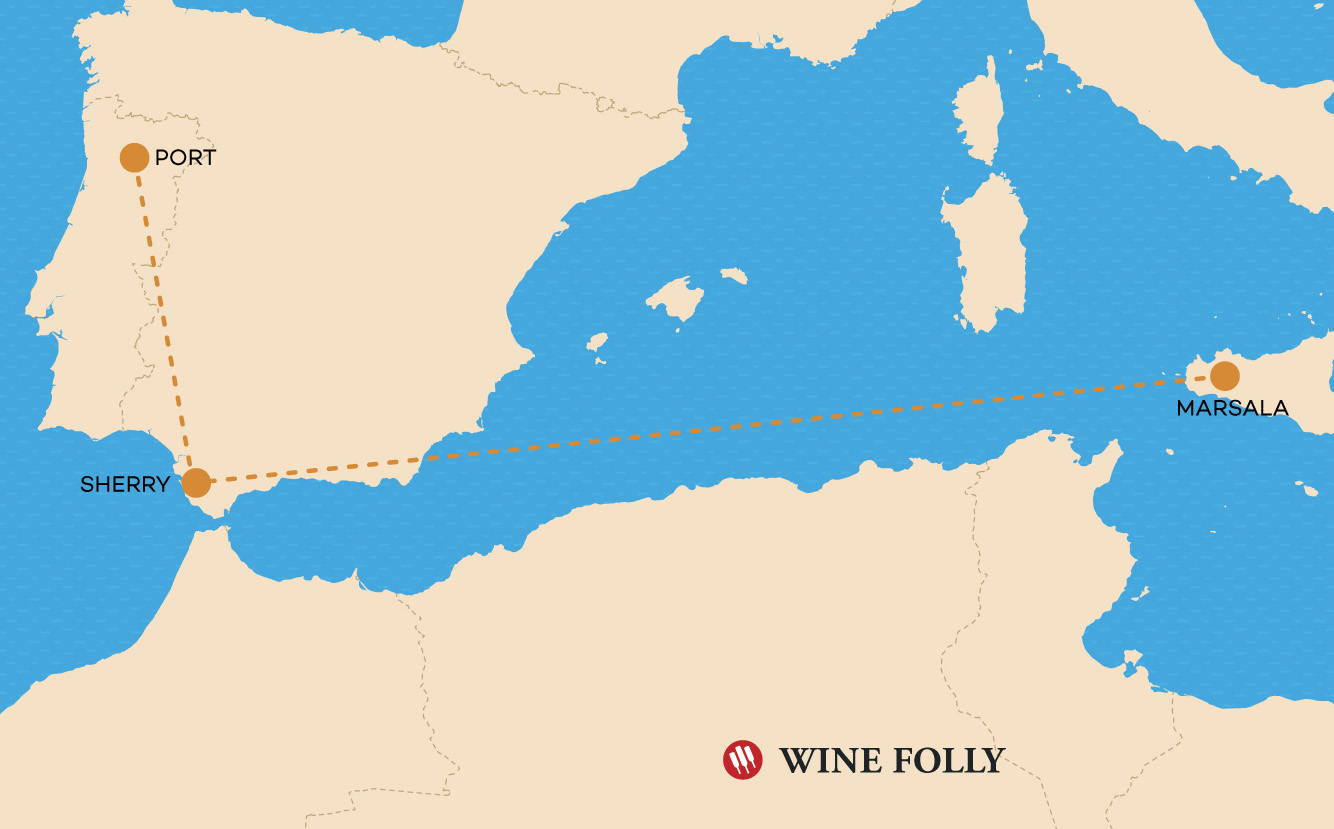Check out this map of 35 great wines from western Europe. Have you tried them all?
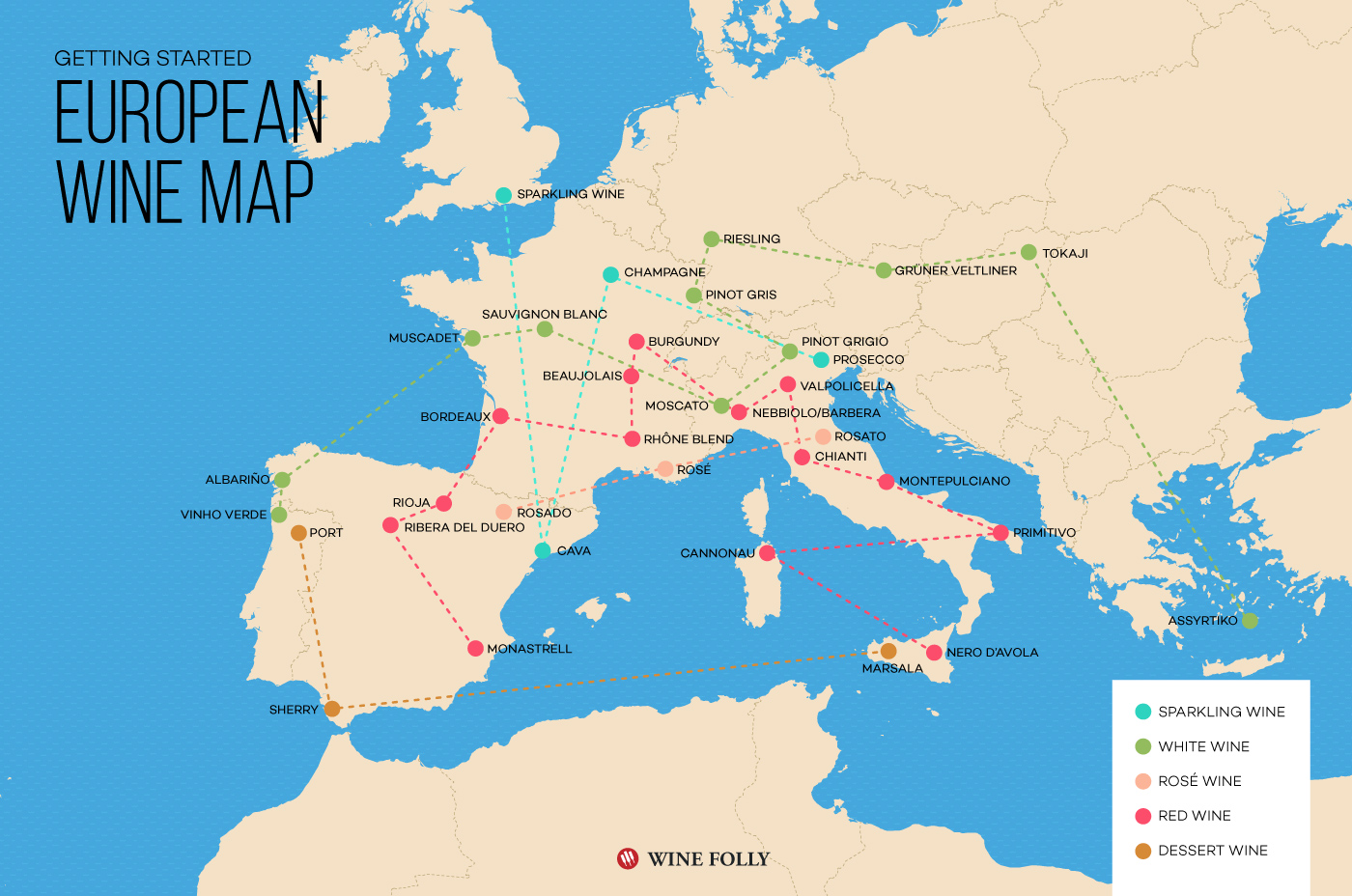
35 classic wines of Western Europe.
If you’re just getting into European wines, these are the classics. The 35 wines included in these maps represent just a tiny fraction of the diversity in European wine, but they also serve to give you a great overview of the major regions and introduce you to the winemaking landscape in this part of the world. This article will encourage you to try some of the greats (such as Champagne and Tokaji), but also many of Europe’s everyday drinking wines (from Montepulciano to Muscadet). Why? Because everyday drinkers are awesome too.
Sparkling Wine
- English Sparkling Wine England has been buying European wines for centuries, so much so that their discerning palates have shaped the taste of the wines that we drink today. You might be interested to know that in opting to produce sparkling wine,the Brits have chosen to produce one of the most challenging wines to make in the world. While you might have a laugh about it, the outcome of their efforts is a series of award-winning English sparkling wines.
- Cava Remove the Champagne grapes of Pinot Noir, Chardonnay, and Pinot Meunier, then replace them with Spain’s own Macabeu (aka Viura), Parellada, and Xarel·lo, and you have the equivalent of Spanish Champagne. Cava even has quality and aging requirements similar to their more famous next-door neighbor.
- Champagne You really can’t say you know sparkling wine until you taste (true) Champagne. That is, at least once. Sparkling wines are often described as fruity and creamy – yet, oddly enough, that isn’t exactly the flavor profile of most Champagne wines. This wine is lithe, startlingly acidic, and somewhat earthy on the nose (think mushrooms and Parmesan cheese) and yet, all of these elements come together and create a fascinating, delicate beverage that seems to breathe on its own in your glass.
- Prosecco When you’re like me, and you like to drink sparkling wine like its beer, you need to find a bubbly solution that will fit a weekly budget. Enter Prosecco, one of the last bubbly fine wines that can be easily attained for well under $20 a bottle. Of course, there is a lot of low-end Prosecco, but once you know how to find the good stuff, you’ll never look back.
White Wine
- Vinho Verde This is the name of a region in Northern Portugal that’s famous for its zesty, melony white wines and tart, lean rosé. Vinho Verde is about as unpretentious as it gets and will make your tacos taste outrageously classy. The regional grape celebrities include two white grapes: Albarinho (aka Albariño) and Loureiro, both of which will blow your mind (they taste a lot like fine dry Alsatian Riesling).
- Albariño The ultimate backpacker’s pilgrimage (aka the Camino de Santiago) finishes in Albariño country. Luckily, Albariño is the perfect choice for the end of an arduous journey with its light flavors crisp apple, lime zest, and pineapple with dry, salty, stony, flavors of citrus and peach.
- Muscadet Compared the to the wines above, Muscadet is a completely different animal even if it still falls into the generalized “light white wine” category. This sucker is lean, dry, and salty, with savory aromas of lager beer and sea shells. Muscadet is the anti-fruit wine, and proudly so. It almost makes a better pairing with raw fish than Sake.
- Sauvignon Blanc If you were wondering where the rest of the world gets its inspiration for Sauvignon Blanc wine, look to the Loire Valley. The region has several appellations producing dry and herbaceous Sauvignon Blanc wines, with the 2 most prominent being Sancerre and Pouilly-Fumé (which happen to be right next to each other). This is one of the places producing the best Sauvignon Blanc in the world… (and P.S. 2015 was an awesome vintage).
- Moscato d’Asti Sweet wine alert! This delicately sparkly, perfectly sweet, white wine will make you wonder why you have poo-pooed sweet wines up until now. Smelling of roses and ripe peaches, served in tiny glasses out of tiny half bottles, Moscato d’Asti is drinking perfume.
- Pinot Grigio Stop drinking all other bottles labeled Pinot Grigio until you’ve tried one from either Alto Adige or Friuli-Venezia Giulia. If you love Pinot Grigio, you need a benchmark to judge the rest. Italy is your wine goddess and she won’t let you down.
- Alsatian Pinot Gris Sweet wine alert! Unlike what they do on the other side of the Alps in Italy, the French make a peachy, off-dry style of Pinot Grigio/Gris that’s in a league of its own. Alsace has no competition with this wine; it’s unlike any other.
- German Riesling Germany produces some of the most amazing Riesling in the world. The most famous German region, the Mosel, is famed for its lime, slate, and smoky Rieslings whereas, farther down the river, you’ll find the Rheingau and Rheinhessen producing more lush stone-fruit-driven Riesling. One you know how German wines are classified, it’s easy to select a quality bottle.
- Grüner Veltliner Austria’s top wine variety is one of the most fascinating new wines to capture the US market. Grüner Veltliner has a lot of similarities to Sauvignon Blanc, including dominant herbaceous, grassy flavors. If you want the best, the Wachau region in Austria is world-renowned for its exceptional Grüner Veltliner wines.
- Tokaji/Furmint The grape is Furmint and the region is Tokaj in Hungary. This area used to be one of the most famous regions when sweet wines like Tokaji were the most important wines in the world. Today, however, you’ll find more Hungarian wines being produced in a dry style and dry Furmint is comparable to fine Chablis.
- Assyrtiko Assyrtiko is now one of Greece’s top wines and the ultimate expression of this grape comes from the tiny island of Santorini where it’s soo hot and dry that the vines are trained into little basket shapes on the ground. Assyrtiko is, and will be, Greece’s most important fine wine in coming years, so if you’re a fan of Pinot Grigio, Sauvignon Blanc, and dry Riesling, this is a must-try.
Rosé Wine
- Rosé, Rosado, and Rosato Three different names for the pink stuff. Each country focuses on different grapes for making rosé wine and each results in unique and different flavors. Try a rosé from each of these countries (Spain, Italy, and France) to get a complete picture of what this style of wine has to offer.
Red Wine
- Monastrell We’ve been calling this wine grape Mourvèdre (as the French call it), but let’s be honest, you’ll find more of this wine in Spain than anywhere else in the world. Monastrell is one of the deepest, darkest, red wines out there and it’s loaded with black fruit, pepper, chocolate, and herbal sage aromas. The regions of Jumilla, Yecla, and Bullas all make exceptional examples, and all at obscenely great values.
- Ribera del Duero They say that Ribera del Duero is 10 months of winter and 2 months of hell. These are the conditions that ripen the local Tempranillo grapes which go into the region’s dense, tannic red wines. The flavors lean towards red fruits from raspberries to plums with a subtle schist-stone minerality. Drink this alongside a piece of roasted meat and you will suddenly understand why red wine is so necessary with a good hearty meal.
- Rioja Spain’s most famous region for Tempranillo makes a much more elegant style with juicy red fruit flavors. The region has a strict classification system that includes oak-aging regimes. This is good because when you buy a “Reserva” because you’ll know exactly what you’re getting into. As a whole, there are 7 valleys of Rioja, all producing subtly different styles and the best values are found in the South (Rioja Baja).
- Bordeaux You cannot drink Cabernet and Merlot without tasting what they taste like from their homeland, Bordeaux (well you absolutely can, but this is more fun). Bordeaux creates some of the most mind-bending examples of Cabernet Sauvignon and Merlot with a strong earthy quality to them. The region is quite large in size, so even though the most expensive wines in the world can be found here, there are also tons of great values.
- Rhône Blend This was the wine that made me realize I’d been missing out on the greatness that is French red wine. If this sounds like you, the Rhône Valley is the place to start tasting French reds.
- Beaujolais Beaujolais is the name of the region and Gamay is the grape. This region is famous for its fruity red wines with light tannin. This is the classic everyday wine of France.
- Burgundy The most expensive Pinot Noir and Chardonnay in the world come from the region of Burgundy (aka Bourgogne). Pinot Noir from Burgundy smells of cranberry-like fruits, roses, and mushrooms. The whites from Burgundy range from the unoaked style from Chablis, to the ultimate French Chardonnay from the Côte de Beaune.
- Nebbiolo/Barbera The two grapes of Nebbiolo and Barbera tell two very different stories about the Piedmont region of Northern Italy. Where Barbera zaps your mouth with an explosion of juicy fruit and acidity, Nebbiolo is a perfumed wine with some of the highest levels of tannins in wine in the world. Best to taste these wines together alongside some Tajarin Pasta.
- Valpolicella Around the city of Verona is the region of Valpolicella, which is most famous for a wine called Amarone. While Amarone costs a pretty penny these days, you can get yourself into the other classifications of Valpo (which use the same grapes) to understand the potential of a wine that exudes cherries, chocolate, and herbal notes.
- Chianti Sangiovese is Italy’s most important grape and Chianti is the most iconic Sangiovese wine. The region of Chianti is diverse and the expressions of Sangiovese are equally complex, so be sure to read up on the region to choose the best bottle for you. Additionally, Montalcino in Tuscany offers another exceptional example of this wine.
- Montepulciano The everyday wine of Central Italy can be light in body with cherry fruit and herbs, or when made well, it can deliver deep blackberry notes, sweet smoke, and leather. Montepulciano d’Abruzzo is perhaps Italy’s most underrated red wine.
- Primitivo Italy’s name for Zinfandel, which is grown in Puglia. The majority of these wines coming into the US focus on sweet, red fruit flavors with subtle notes of leather, but the serious stuff offers deeper blackberry flavors and smoky notes. The region of Puglia should be known for its exceptional quality.
- Cannonau Cannonau is Sardegna’s name for Grenache. The wines are unlike any Grenache wines you’ll have anywhere, with intense leathery flavors and the twinkle of strawberry fruit. Cannonau is the perfect pizza wine.
- Nero d’Avola Sicily’s major red grape, Nero d’Avola, has a likening to fine Cabernet Sauvignon when it’s made right. This grape deserves a place alongside the other great reds of the world and yet it’s still approachable nowadays!
Dessert Wine
- Port The first official, demarcated fortified wine in the world is from the Douro Valley in Portugal. The region is now a UNESCO Heritage site due to the influence of human agriculture on the rugged, mountainous landscape. The best Ports can be found by understanding the different classifications. By the way, Port wine pairs with some of the most sumptuous desserts.
- Sherry Sherry has garnered a bad name due to the overwhelming amount of cream sherry (a sweet wine) on the market. In truth, most high-end Sherry wines are dry, which completely changes the perception of this wine to something more akin to fine whiskey.
- Marsala Another region that suffers from too much sweet cooking wine entering the US market. In truth, great Marsala wines aren’t as sweet as they are smoky. Once you know more about this wine, you’ll find yourself delighting in how affordable the good stuff is.
